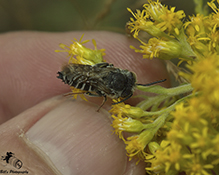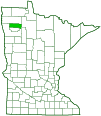eight-toothed cuckoo leaf-cutter bee
(Coelioxys octodentatus)
Conservation • Description • Habitat • Ecology • Distribution • Taxonomy
|
|
||||||||||||||
Description |
Eight-toothed cuckoo leaf-cutter bee is a small, black, solitary, kleptoparasitic, leafcutting bee. Females are 5 ⁄16″ to ½″ long. Males are a little smaller, 5 ⁄16″″ to ⅜″ in length. The thorax is broad and black. The hardened plate on the upper (dorsal) side of the first segment of the thorax (pronotum) is saddle-shaped. It has a small rounded lobe on each side that does not reach the tegula. The front (anterior) and rear (posterior) of the thorax have a dense fringe of white hairs. The first abdominal segment is fused to the thorax and gives the thorax the appearance of having four segments. The abdomen is black, broad, and striped with narrow, very dense bands of short white hairs at the rear (posterior) of each segment. The abdomen of the female is cone-shaped, tapering to a very sharp point that allows it to pierce the nest of other bees. The male abdomen is armed with eight spines or teeth. There are no pollen-carrying hairs on the underside of the abdomen. The head is black. There are two large compound eyes, one on each side of the head; and three small simple eyes (ocelli) in a triangular pattern at the top of the head (vertex) between the compound eyes. The two lateral ocelli are closer to each other than they are to the edge of the vertex. The antennae are thread-like and are not elbowed. They have 12 segments. The mandibles have 4 teeth. The tongue is long and slender. The legs are brick-red or rust-colored from the large third segment (femur) to the foot-like segments (tarsi). There are no pollen-carrying hairs pollen baskets on the hind legs. |
Size |
Female: 5 ⁄16″ to ½″ Male: 5 ⁄16″″ to ⅜″ |
Similar Species |
Habitat |
|
Ecology |
Season |
One generation: May to October |
Behavior |
|
Life Cycle |
The female does not build a nest. It has no pollen-carrying adaptations that would allow it to provision a nest. Instead, it lays a single egg in the nest of a twig-nesting or wood-nesting bee, mostly those in the genus Megachile, but also Osmia and Anthophora. The egg hatches almost immediately. The newly hatched larvae uses its sharp mandibles to cut the egg or larva of the host in half. Eleven to sixteen days after hatching, the larva spins a cocoon. |
Larva Food |
Pollen provisioned by the nest builder |
Adult Food |
Flower nectar |
Distribution |
||
|
Sources |
|
| 8/16/2025 | ||
Occurrence |
||
|
||
Taxonomy |
|
Order |
Hymenoptera (Ants, Bees, Wasps, and Sawflies) |
Suborder |
Apocrita (Narrow-waisted Wasps, Ants, and Bees) |
Infraorder |
Aculeata (ants, bees, and stinging wasps) |
Superfamily |
Apoidea (bees and apoid wasps) |
Epifamily |
|
Family |
Megachilidae (mason, leafcutter, carder, and resin bees) |
Subfamily |
Megachilinae |
Tribe |
Megachilini |
Genus |
Coelioxys (sharptail bees) |
Subgenus |
Boreocoelioxys |
Subordinate Taxa |
|
|
|
Synonyms |
|
Coelioxys altilis Coelioxys atlantica Coelioxys brevis Coelioxys catalinica Coelioxys coquilletti Coelioxys crassula Coelioxys cressoni Coelioxys mediata Coelioxys megatricha |
|
Common Names |
|
eight-toothed cuckoo leaf-cutter bee |
|
Glossary
Femur
On insects and arachnids, the third, largest, most robust segment of the leg, coming immediately before the tibia. On humans, the thigh bone.
Ocellus
Simple eye; an eye with a single lens. Plural: ocelli.
Tarsus
On insects, the last two to five subdivisions of the leg, attached to the tibia; the foot. On spiders, the last segment of the leg. Plural: tarsi.
Tibia
The fourth segment of an insect leg, after the femur and before the tarsus (foot). The fifth segment of a spider leg or palp. Plural: tibiae.
Vertex
The upper surface of an insect’s head.
Visitor Photos |
||
Share your photo of this insect. |
||
This button not working for you? |
||
Bill Reynolds |
 |
MinnesotaSeasons.com Photos |
||
|
||
|
||

Slideshows |
|

Visitor Videos |
||
Share your video of this insect. |
||
This button not working for you? |
||
|
Other Videos |
||
cuckoo-leaf-cutter Bee taken with samsung grand prime |
About
Published on Sep 4, 2016 Macro video by smartphone |

Created: 9/2/2017 Last Updated: © MinnesotaSeasons.com. All rights reserved. |


